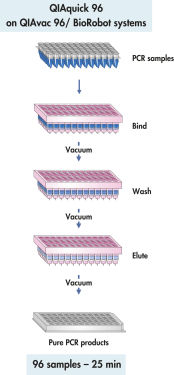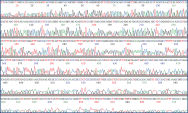✓ オンライン注文による24時間年中無休の自動処理システム
✓ 知識豊富で専門的な製品&テクニカルサポート
✓ 迅速で信頼性の高い(再)注文
QIAquick 96 PCR Purification Kit (4)
Cat. No. / ID: 28181
✓ オンライン注文による24時間年中無休の自動処理システム
✓ 知識豊富で専門的な製品&テクニカルサポート
✓ 迅速で信頼性の高い(再)注文
特徴
- すぐに使えるDNAの最大95%の回収率
- 迅速かつ便利な操作
- 3つの容易なステップで最大10 kbのDNAのクリーンアップ
製品詳細
QIAquick 96 PCR Purification Kitsは、>100 bpサイズのPCR産物のハイスループットシリカメンブレ精製用96ウェルプレート、バッファー、およびコレクションチューブで提供されます。最大10 kbのDNAを、シンプルで迅速な結合–洗浄–溶出の操作と60–80 µlの溶出液量で精製します(結果的に、溶出物の量は40–60 µl)。このクリーンアップ操作は、QIAquick 96 PCR BioRobot Kitを使用してBioRobot Universalワークステーションで完全自動化できます。
パフォーマンス
図参照
原理
QIAquick 96 Kitsは、高塩濃度バッファーでDNAを結合し、低塩濃度バッファーまたは水で溶出するためのシリカメンブレン技術です。この精製操作は、DNAサンプルからプライマー、ヌクレオチド、酵素、ミネラルオイル、塩、アガロース、臭化エチジウムなどの不純物を除去します。シリカメンブレン技術は、緩い樹脂やスラリーに伴う問題や不都合がありません。特殊な結合バッファーは、特定のアプリケーション向けに最適化され、特定のサイズ範囲内でのDNA分子の選択的吸着を促進します。
QIAquick 96の手順では、QIAvac 96上で効率的な真空操作にて、最大96のPCR産物を並行して精製することができます。
QIAquick 96 PCR BioRobot Kitは、BioRobot Universalでの使用に最適化された特別なキットです。このキットは、96 PCRサンプルの自動ハイスループットクリーンアップに必要なすべてのバッファーとプラスチックウェアと共にQIAquick 96モジュールを提供します。
操作手順
QIAquickシステムは、シンプルな結合–洗浄–溶出の操作です(「 QIAquick 96の操作手順」のフローチャートを参照)。結合バッファーは、PCRサンプルまたは酵素反応液に添加し、混合液を96ウェルプレートにアプライします。核酸は、バッファーの高塩濃度の条件下でシリカメンブレンに吸着します。不純物は洗い流され、純粋なDNAが、少量の低塩濃度バッファーまたは水と共に溶出し、後のアプリケーションに使用できます。
取り扱い
QIAquickマルチウェルモジュールは、QIAvacマニホールドと真空操作にて使用します。QIAquick 96 PCR Purification Kitは、QIAvac 96真空マニホールドが必要です。このクリーンアップは、QIAquick 96 PCR BioRobot Kitを使用してBioRobot Uworkstationsで完全自動化できます。
図参照
アプリケーション
MinEluteまたはQIAquickシステムで精製したDNAフラグメントは、シークエンシング、マイクロアレイ解析、ライゲーションと形質転換、制限酵素消化、標識、マイクロインジェクション、PCR、およびin vitro転写など多くのアプリケーションで直接使用できます。
裏付けデータと数値
QIAquick 96の操作手順。
QIAquick 96 Kitは、QIAvac 96またはBioRobot Universal Systemと共に、結合-洗浄-溶出の操作です。

Specifications
| Features | Specifications |
|---|---|
| Binding capacity | 10 µg |
| Processing | 手動/自動 |
| Removal <10mers 17–40mers dye terminator proteins | 除去<40mers |
| Sample type: applications | DNA、オリゴヌクレオチド:PCR反応 |
| Format | 96ウェルプレート |
| Fragment size | 100 bp ~ 10 kb |
| Technology | シリカテクノロジー |
| Recovery: oligonucleotides dsDNA | 回収:オリゴヌクレオチド、dsDNA |
| Elution volume | 60 ~ 80 µl |



